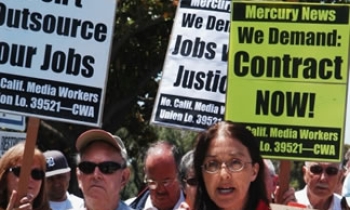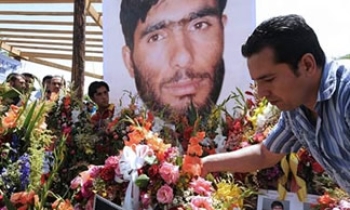Nichols and McChesney have written a very readable book that describes well the current state of the U.S. media, illustrates the media’s serious recent mal-performance with enlightening case studies, and discusses what can be done about it.
The authors put their analysis of the current state of the media in a historic and normative context. Media diversity has diminished hugely since the 19th and early 20th century. In the years just before World War I there were not only many more newspapers than today, there were many hundreds of socialist and other dissident papers and journals, which were important contributors to the significant reforms enacted in those years. The World War and follow up "red scare" and crackdown decimated the dissident media and since then we have seen a steady growth of commercialization and centralization. These adverse trends were accelerated with the 1996 Telecommunications Act and the Republican triumphs in 2000 and 2004. The powerful bottom-line orientation of the media, the intense competition for advertising, the desire to gain government support for further growth by merger, and by subsidy in the form of rights to public channels without charge, has made the big media cautious, conservative, and manipulable. The rise of the right-wing media echo-chamber and blogosphere has helped make the media still more manageable and de facto servants of the state. These developments are catastrophic given the theoretical and critical role of the media as watchdogs against government and private abuse and providers of information to the public that would allow them to participate in the political process as independent and knowledgeable citizens.
The book’s title, Tragedy & Farce, is taken from an 1822 statement by James Madison that, "A popular government without popular information or the means of acquiring it, is but a Prologue to a Farce or a Tragedy or perhaps both." Nichols and McChesney make a good case that our founding fathers were worried about the abuse of the war-making power and would have been aghast at the failures of the contemporary media and their transformation from any kind of watchdogs to lapdogs and agents of government war propaganda, in the process providing a "liar’s paradise."
The authors illustrate the liar’s paradise with a very good analysis of the media’s performance during the "embedded war." They point out that every war elicits patriotic coverage, but in this case the coverage of the Iraq invasion-occupation was devastatingly bad well before the war, despite the extreme weakness of the case made by the Administration, its threatened gross violation of international law, and the fact that there was mass opposition to the war by the civil society that would have supported a more honest and less government-subservient journalism. Despite this mass opposition, representation of the antiwar position in the media was slight; dependence on official sources was huge, and the willingness to use critical sources and even adhere to basic criteria of evaluation of alleged evidence was almost completely absent (as in the remarkable acceptance and praise of Colin Powell’s presentation before the UN in February 2003). And "if the abdication of any notion of elementary journalism in the coverage of Powell’s UN speech was tragic, the press conduct at Bush’s last prewar press conference was a farce"–no hard questions, with the Washington press corp performing like "court reporters." Embedded journalism plus "fullthrottle jingoism on U.S. television" precluded critical journalism.
The authors point to the crushing indictments of the media in the admissions of seriously flawed coverage of the run-up to the war by the New York Times and Washington Post, but they note that it was left to a small town paper in Fredericksberg, Virginia to apologize to the public on behalf of the news media. Rick Mercier wrote in the Free Lance-Star on March 28, 2004: "Sorry we let unsubstantiated claims drive our coverage. Sorry we were dismissive of experts who disputed the white House charges against Iraq . Sorry we couldn’t hold the administration’s feet to the fire when it really mattered." As another indication of the huge journalistic failure, the authors note the large numbers of Americans who believed in the fall of 2004 that Saddam possessed WMDs and had supported al Qaeda –"a more thorough repudiation of the press could barely be imagined."
But the media not only failed to serve the public interest on the critical issue of war, it did very badly on the equally critical matter of elections. Nichols and McChesney have two excellent chapters that present a very strong case that the media played a key role in making the 2004 presidential election both a tragedy and a farce. In "Policing the Primaries," they argue that Karl Rove was fearful of the Howard Dean candidacy and wanted very much to have John Kerry as a candidate, as the former could take an antiwar position whereas the compromised Kerry could not. The media obliged Rove, eventually finding Dean too far out–the "scream" fraud was only one facet of a systematic campaign of derogation that effectively removed Dean from serious consideration. Kucinich was even more quickly eliminated by a media determination that he was not a "serious" candidate. His strong effort to inject a discussion of issues in the campaign was brushed aside in this media "policing" of the primaries.
In their chapter on "The Media and the November Election," the authors show that Kerry was a poor candidate, not only unable to take a convincing and critical position on Bush’s war, but also incapable of working well in an environment where facts and reason were not very important, but aggressive attacks and dramatic claims and positions worked. Of course this Bush edge was greatly aided by the Bush campaign’s appeals to patriotism and fear-mongering, by the power of the presidency, the aid of the unscrupulous right-wing media (Fox, Sinclair, and others), and the cowed "liberal media." The failure of the New York Times to run an article just before the election on Bush’s "box" under his coat, pointing to illicit electronic communication during the debates, and CBS’s unwillingness to run a program on Bush’s doctoring of evidence on the runup to the Iraq invasion, again allegedly because the election was so near, suppressed news relevant to voters’ electoral choices and were pure gifts to the Bush campaign. In reference to CBS’s decision (which could well apply to the New York Times), "Then we can be clear about what happened in the Fall of 2004: CBS News [and by the same reasoning, the New York Times] ceased to be a news organization."
At least equally scandalous was the media treatment of the Swift Boat veterans attacks on Kerry, to which the media gave a great deal of attention, and in a miracle of media bias helped make the Vietnam veteran Kerry look bad while the service-evader Bush was allowed to go unscathed. The authors have a good review of this case and of Rathergate. In their discussion of the Swift Boat campaign, the authors argue that Kerry could have squelched that attack by an aggressive counter-attack. This is debatable, as is their view that a strong Kerry attack on media performance and media concentration might have done him a lot of good, if not turning the tide. As they acknowledge earlier, Howard Dean’s attack on the media did not help him very much and any turn in this direction, while it might be on target and excite supporters, might well have caused the media to turn even nastier to such a challenger.
The authors also discuss the media’s unwillingness to take seriously the claims and evidence of fraud in the 2004 election where the media even managed to attack John Conyers for studying and holding hearings on this issue–he was "grandstanding." The media’s failure to take this important issue seriously minimizes the pressure to enact reforms that would make national elections fraud-free and, along with their treatment of matters like the Swift Boat veterans and Bush campaigns for war (earlier Iraq, currently Iran), does not bode well for the future of the U.S.’s shrinking democracy.
A relatively unique feature of Tragedy & Farce is its focus on solutions. The authors are leaders of the organization Free Press whose aim has been to build a constituency for democratic media reform. They stress that, in the past, media policy has been insider negotiated with zero public information and participation and they have tried to do something about this. Free Press, which had 15 full time employees and a membership of 200,000 in mid-2005, tries to make media policy more democratic by forcing debate out in the open with public participation. Their efforts undoubtedly played a role in stopping the further erosion of media ownership rules in 2003 by arousing awareness and stimulating discussion and responses of affected groups and grassroots organizations. Their conferences on media issues in 2003 and 2005 were well attended and got some publicity.
The authors recognize that media policy reform is only one route to constructive change, along with media criticism and the development of alternative and noncommerical media. My own feeling is that maximum priority should be given to the development of alternative media for two reasons: one is that reform of the dominant media through political processes is extremely difficult because media resistance is most focused here, and two is because getting actual behavioral changes within the media runs into the obstacle of the commercial imperatives that determine behavior. While resistance to new and alterative media may be strong, it is likely to be less so than to direct and immediate challenges to big media interests. Also, the behavior of the alternative media is more easily influenced by public interest motives. Still, the focus of Nichols and McChesney is important and can have wider impact than media reform alone. Their book is a real contribution to understanding the entire range of media issues.
Edward S. Herman is an economist and media critic.









